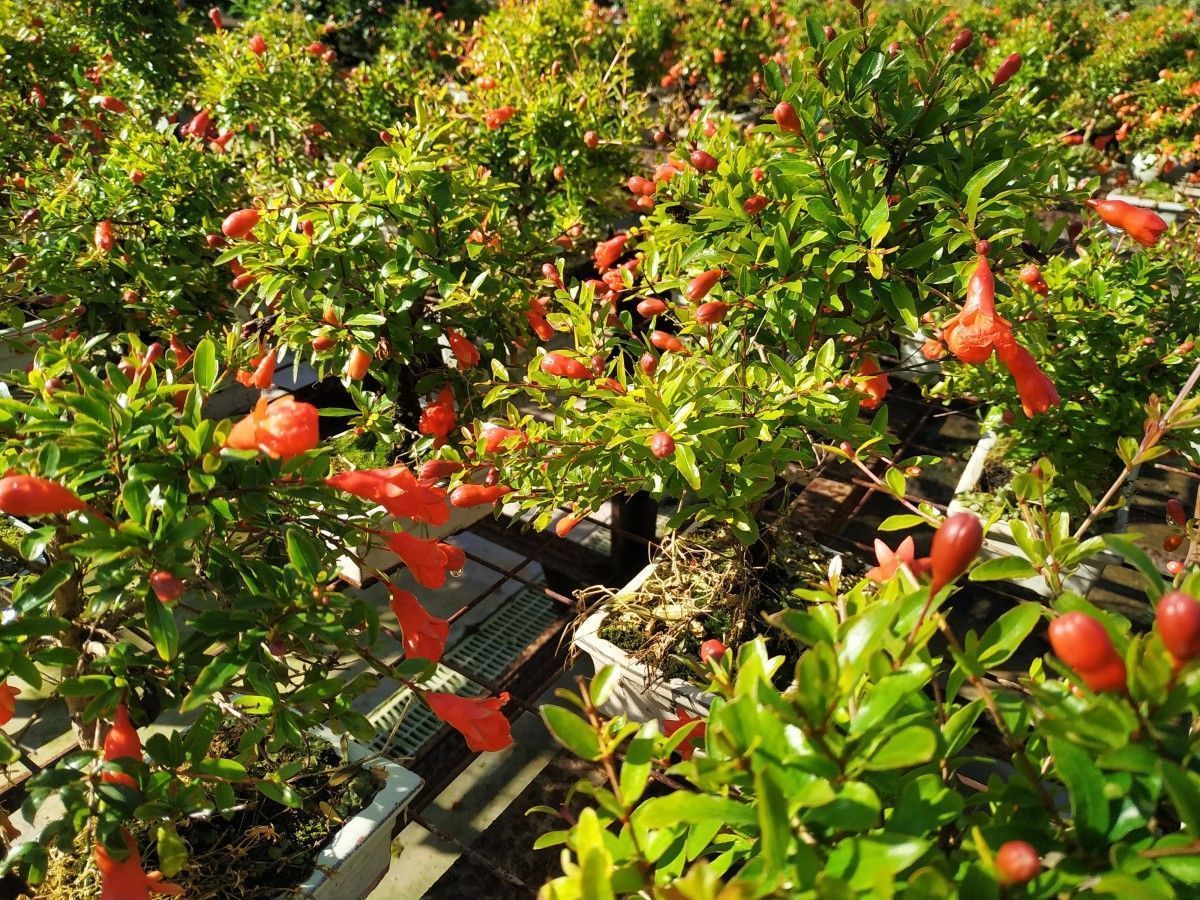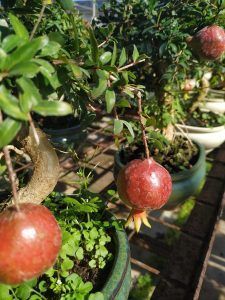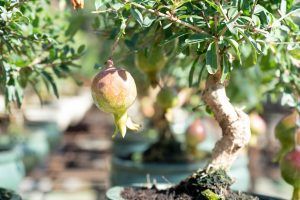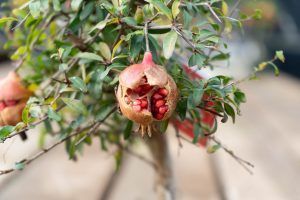Pomegranate bonsai, a bonsai classic

Today I want to talk to you about a classic tree, the pomegranate bonsai or Punica granatum. A species that, without a doubt, should be part of any bonsai lover’s collection. It is a tree with delicate bark, beautiful scarlet flowers and spectacular fruit. Wouldn’t you like to have a bonsai with these features?
The pomegranate tree belongs to the punicaceae family, which is widespread throughout the world. Is native of the Mediterranean, Western Asia (Persia and Afghanistan, northwest India) up to the Himalayas. It is a shrub or small tree up to 5 m tall, deciduous, thorny and very branchy. Pomegranates have opposite, oblong, shiny leaves.
Its name comes from a mistake by a very famous naturalist, Pliny, who, when cataloguing the tree, catalogued it as the apple of Carthage “malum punicum”, from the Latin “punicus” or Carthage. Likewise, granatum means pomegranate, that is, with many grains, precisely because of the large number of seeds that its fruit contains.
Keep reading to find out all about caring for the pomegranate bonsai.
Where we should place the Pomegranate bonsai
With the Mediterranean climate, it can be outside all year round. Remember that you must protect it if there is frost in your region. You can bring it into your house or place it inside a greenhouse. On the other hand, if you live in a continental or mountain climate, you can place it outside, as long as the temperature is in the 10ºC to 25ºC range. We should protect it from intense sunlight and from freezing weather, placing it in partial shade in the summer and in a greenhouse in the winter.
Watering and fertilizing

Fertilizing should be done both in the spring and autumn. In the Spring we give priority to fertilizers rich in nitrogen for growth and that are balanced in phosphorus and potassium for the proper formation of its flowers.
In the autumn, we continue with the fertilizers that are rich in phosphorus and potassium, lowering the nitrogen that is not so essential at this time. You can use a combination of solid and liquid organic fertilizers.
Transplant and substrate of a pomegranate bonsai
The pomegranate bonsai can be transplanted every two years. A balanced substrate is good for it, if you are a bonsai beginner, you can use Terrabonsai, a mixture of blonde peat, Akadama and gravel.
If you already have experience in the bonsai world, you can try a 100% Akadama substrate or a mixture of 70% Akadama and 30% gravel.
Flower and fruit
The pomegranate bonsai blooms in the summer and its flowers are oval-shaped. They have a vivid scarlet colour and leathery calyx. These flowers later become the well-known yellow or red fruit, the pomegranate. Its red pulp is very juicy and edible.
Remember to not wet the flowers when watering. This would cause the flowers to last much less time on the tree. In order for pomegranates to bear fruit, they must be outside for insects to pollinate them. Remember that, to save your bonsai’s energy, once the fruit has appeared and matured, you should only pick 1/3 of them. That way we will not waste the bonsai’s energy.
The Pruning, clamping and wiring of the Pomegranate bonsai
The Pomegranate tree can be pruned throughout the year, although it is recommended to do it at the beginning of spring budding, so you will not prune the flower buds at the end of the branches that swell.
We clamp up to one or two pairs of leaves during the spring stage, trying to take into account the direction of the last leaf, since this will mark the direction of the next budding.
If you want the tree to flower, wait until the tree has flowered before pruning. The thicker terminal buds should also be removed in order to better balance growth.
You should do the wiring of the branches between the spring and autumn, in any case we will avoid doing it during flowering so as not to damage it.
The most common infestations
Typically, pomegranate tree infestations include mealybugs, aphids, red spider mite and sometimes blight. For these diseases, there are systemic insecticides that treat each of them. The important thing is to keep your bonsai healthy and strong so that it can resist disease.
Bonsai styles that we can create in a pomegranate tree
With your pomegranate bonsai, you can create: Chokkan (formal), Moyogi (informal), Sakkan (tilted), Hokidachi (broom), Fukinagashi (windswept), Neagari (exposed roots) or Yose-Ue (forest).
You can also make beautiful penjing from your pomegranate bonsai. It is very versatile in terms of design and, in addition, they have the additional appeal of their flowers and fruits. Do you want to give it a try? Of course! We hope you will tell us about your experience with a pomegranate bonsai.
Until next time!
You may also be interested in…
About the Author
Mistral Bonsai
In Mistral Bonsai we are a communication team, technicians and masters committed from the first day to disseminating the wonderful art of bonsai. A world that offers many things to share. We believe that a bonsai is a tree with a soul, unique and unrepeatable. Another of our most essential pillars is, how could it be otherwise, our close commitment to the preservation of the environment and nature.
Categories
Bonsai cultivation and care (60)
Bonsai gift (2)
Bonsai pests and diseases (7)
Bonsai repotting (3)
Bonsai species (1)
bonsai substrates (2)
Bonsai summer (1)
bonsai tools (1)
Bonsai work (13)
Ceramic pots (3)
Chinese culture (1)
Chinese culture (2)
Coniferous bonsai (2)
Conifers (1)


